
|

|
|
by Stephan Leinhäuser and Thomas Schmidt-Uhlig
Translation by Marc Schulz and Thomas Schmidt-Uhlig

|

|
|
Translation by Marc Schulz and Thomas Schmidt-Uhlig
This theme set is not an official set. Neither Klaus Teuber, nor Franz Vohwinkel, nor Kosmos have tested or authorized it.
IDEA:
Though Klaus Teuber wanted Catan to be a peaceful country, I always liked the idea that
war might break out. In times of war, of course, different rules should apply,
since war is an unusual state. With this Set there always is the chance of war between
the Principalities.
DEVELOPMENT:
Somehow I got in contact with Thomas Schmidt-Uhlig by email, and I asked him if
he'd like to participate in the development of a Theme Set. He was enthusiastic and
so we started. We wrote a lot of emails with a variety of ideas, cards, rules and
images. For some cards we modified and adapted ideas of other people (thanks to
Jan Creutzenberg and Simi (her cards unfortunately have finally not been included,
because...)), and some cards have been excluded again, because the Set would
have been too large.
RULES:
The game is played with all cards of a Base Set plus up to two Theme Sets and this Set
War & Peace. The central cards (in this case:
Weapon Smithy
and Triumphal Arch) are sorted out, all other cards
are shuffled. Afterwards the cards are separated into six piles. The known rules for
the Theme Sets are not used with this set, which I would also recommend for all other
Theme Sets.
PREPARATION:
You take a water resistant pen and paint one of the question marks of an Event Die black.
For an ordinary game without this Theme Set the black question mark still indicates an Event.
For War & Peace, however, it indicates the beginning of war.
Initially the game is played according to the usual rules, peace reigns the Principalities. As soon as both players have 3 Victory Points, the black question mark counts and initiates war, i.e. the first Battle takes place and the Rules of War apply. After the war (not the Battle) the game is again played according to the usual rules - until the next war starts.
WAR DIE:
This die shows different Events:
|
BATTLE:
When a war starts or if a Battle is rolled, both players roll the Production Die
and add all their Strength Points to the rolled number. Be careful: Some cards have
a different Strength during war and during peace. Don't forget your Fleets. The sum is the
Battle Strength. The player with the highest Battle Strength wins the Battle.
If a player rolls a 1 upon determining the Strength Points, he succeeds in killing
a Knight or sinking a Fleet of the opponent. If there are no (more) Knights or Fleets,
other cards related to war can be destroyed (In this order: Dragons, War Units, Cannons,
Militia, Mercenary Army etc.). To kill/sink/destroy means that the opponent has to
return the card to his hand.
In a Sea Battle only the Strength Points of Fleets are added to the number rolled with the Production Die. However, Harbors still have their fortifying effect. Upon rolling a 1, only a Fleet may be sunk.
In a Land Battle the Strength Points of Fleets are disregarded. Upon rolling a 1, Fleets may not be sunk.
The first player to achieve 15 Victory Points (or more, as you like) during his turn wins the game. I always play that in order to win you must have an advantage of at least 2 Victory Points. This makes the end of the game more interesting and exciting...
THE CARDS IN DETAIL:
(The background image of the card explanation
shows the card backside and therefore the corresponding card stack)
 |
Hostile Attack (1x)
Each player has to return a War Unit or a War Fleet to his hand. The opponent decides, which card this is. |
|||
 |
Dungeon (1x)
When you roll a 1 in a Battle, i.e. when you would kill an opponent's Knight, then you may put this Knight into the Dungeon (underneath the card) as a prisoner of war. In times of peace your opponent may ransom the Knight and lay it out again in his Principality. The ransom is 1 Gold for you. The Dungeon can hold an unlimited number of Knights and Dragons, but of course no Fleets or War Units. However, you may not lay out the cards yourself. If your opponent wants (and is able) to ransom the Knight, you have to return it to him. |
|||
 |
Mercenary Army (2x)
Each player may only build one Mercenary Army. Once per turn you can increase the Strength by 1 by paying 1 Gold and rotating the card. The Mercenary Army can be destroyed by a Black Knight and saved by a Herb Witch. Cards like Castle, Smithy, Civil War etc. have no effect on the Mercenary Army. In times of war the Strength Points of the Mercenary Army are doubled. |
|||
 |
Fortified Sentry (2x)
The Fortified Sentry is placed on an existing Road. From then on you may place a War Unit, a Cannon or a Knight (no Armies, no Fleets) adjacent to each adjacent Region Card (above and below). The prerequisites for those cards have to be respected. The Cards are not protected by cards belonging to the adjacent cities. Example: Knights are not protected from Civil War by a Church, but of course by a Cathedral. If the Fortified Sentry is destroyed (e.g. by an Arsonist), the adjacent Units remain. If they are also destroyed, they may not be rebuilt. |
|||
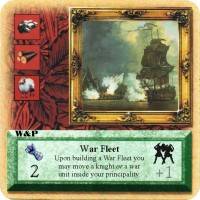 |
War Fleet (3x)
The War Fleet is a mixture of a Fleet and a Knight, i.e. it has some of the advantages and disadvantages of both. If you play a War Fleet, you may immediately move a Knight or a War Unit to another place. The War Fleet is not unique (for Tournament Play). The following cards act on a War Fleet: Black Knight, Herb Witch, Civil War, Smithy, Church, Privateering Fleet, Metropolis, Dockyard, Fleet Maneuver, War Harbor. The following don't: Castle, Tournament Grounds, Imelda, Brothel, Bribery, Horse Ranch. |
|||
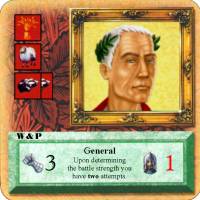 |
General (1x)
The General is a Knight and therefore unique for Tournament Play. In times of war you can roll the Production die once more upon determining the Strength Points. However, in this case the second roll counts, so you should carefully think before rolling. |
|||
|
War Units:
Prerequisite for building War Units is the Weapon Smithy. During war the cost for building a War Unit is reduced by 1 resource of your choice. War Units do not count as Buildings, i.e. they can be stolen by a Spy or built adjacent to a Region Card of a Metropolis, but they can be destroyed by an Arsonist. Smithy, Castle and similar Buildings don't have any effect on War Units. In times of peace the Strength Points of a War Unit are those shown on the left side of the card below the glove. During war they have a higher number of Strength Points, which is shown on the right side below the symbol of war (for an example see Ballista). The symbol for the War Units is the axe: |
||||
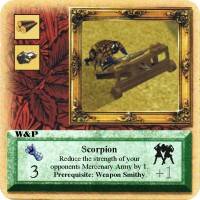 |
Scorpion (1x)
If you play this card, you may rotate your opponent's Mercenary Army (if present) and reduce the number of gloves shown on the card by 1. If it only shows 1 glove, your opponent has to return the Mercenary Army to his hand. The Scorpion was one of the lighter artillery weapons. It fired long, arrow-like bolts, stones or iron balls. It existed in different sizes, but it always resembled a large bow. Sometimes the Scorpion was mounted on a tripod, but usually on a movable wooden frame. |
|||
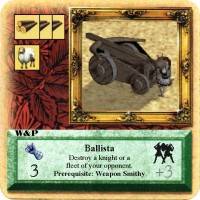 |
Ballista (1x)
If you play this card, your opponent has to return one of his Knights or Fleets of your choice to his hand (also Pirate Fleet, Privateering Fleet or Great Trading Fleet). Prerequisite for the Ballista is the Weapon Smithy. During war the cost for a Ballista is reduced by any one resource of your choice, and it has 6 (3+3) Strength Points. Upon determining the War Strength all 6 Points are considered (except for a Sea Battle, then none), when determining the owner of the Knight Token only the 3 'ordinary' Strength Points. The Ballista was a kind of crossbow, which, due to its enormous size, was mounted on a movable frame. The Ballista fired spears or large bolts. |
|||
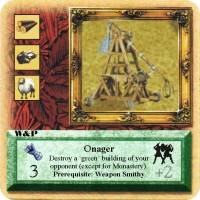 |
Onager (1x)
If you play this card your opponent has to return a 'green' Building of your choice (except for Monastery, no Units) to his hand. (The idea for this card is from Jan Creutzenberg) |
|||
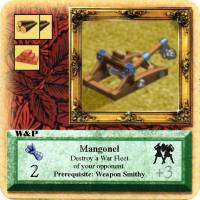 |
Mangonel (1x)
If you play a Mangonel, your opponent has to return a War Fleet to his hand. The Mangonel was a development of the Onager. It could throw stones and other objects in the direction of a target. For this purpose it used a horizontal bar that stopped the throwing arm in its vertical position. Usually the Mangonel was built directly at the place of operation, but variants on movable frames also existed. |
|||
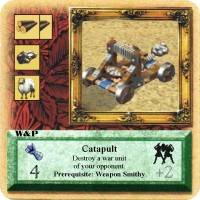 |
Catapult (1x)
If you play this card, your opponent has to return a War Unit or a Cannon to his hand. The Catapult was a development of the Mangonel. It could throw larger weights over longer distances. |
|||
 |
Trebuchet (1x)
If you play this card, your opponent has to return a City Upgrade Card of your choice to his hand. You may only choose City Upgrade Cards without Victory Points. The Trebuchet was the most powerful medieval weapon. Like the Catapult it used a throwing arm, but the stones (or other objects) were placed inside a leather sack that was tied to the end of the throwing arm with ropes. Upon firing the trebuchet, a large centrifugal force acted on the sack and increased the height and the distance that could be achieved. |
|||
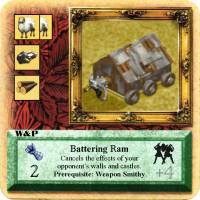 |
Battering Ram (1x)
The Battering Ram cancels the effects of all your opponents Walls (Great Wall (S&P), Border Rampart (S&M) etc.) and Castles (Castle, Knight's Keep (P&I), Robber Knight's Castle (T&C) etc.). Rotate the cards by 90 degrees. The Battering Ram has no effect on Walls and Castles that are built after playing the Battering Ram. Your opponent has to pay half of the building costs (round up) to get his cards back again. The Battering Ram was an instrument to break walls and gates. A typical Ram consisted of a tree-trunk mounted on wheels or hung in a frame in a manner that allowed the tree-trunk to swing forwards and backwards. To make the Battering Ram more durable often the head of the tree-trunk was covered with metal plates. |
|||
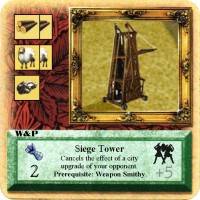 |
Siege Tower (1x)
If you play the Siege Tower you can cancel the effect of an opponent's City Upgrade of your choice. Rotate the card by 90 degrees. Your opponent may not use any advantage (e.g. as prerequisite for other cards). Your opponent has to pay half of the building costs (round up) to get his cards back again. With a Siege Tower you were able to get close to high walls and to overcome them. Often Siege Towers were also equipped with a Battering Ram. |
|||
 |
Triumphal Arch (2x)
The Triumphal Arches are placed face-up next to the Development Stacks. Each player may only build one Triumphal Arch. If you win a war for the first time, you may immediately build a Triumphal Arch for free, provided you have an empty building site for a City Upgrade Card. For your following victories, simply rotate the Triumphal Arch by 90 degrees to increase the number of Victory Points by 1. The Triumphal Arch is not affected by an Arsonist or similar cards, only the number of Victory Points can be reduced by a Trojan Horse. |
|||
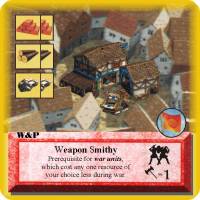 |
Weapon Smithy (2x)
Also the Weapon Smithies are placed face-up next to the Development Stacks. Each player may only build one. The Weapon Smithy is a prerequisite for all War Units, the Trojan Horse and some Action Cards. Furthermore you are allowed to build a Cannon without having a University. However, building a Cannon always costs 1 Ore and 1 Timber regardless of peace or war. For the Catapult the Cannon counts as a War Unit. |
|||
 |
War Harbor (1x)
In times of war the Strength Points of all Fleets are doubled. Simple Trading Fleets have 2 Strength Points, in combination with a Harbor 3 (1 x 2 + 1 = 3), War Fleets have 6 ((2 + 1) x 2 = 6) and Privateering Fleets 2 Strength Points. Doubling the Strength Points is done before any effect of other cards like e.g. the Harbor is considered. |
|||
 |
Fortress (2x)
The Fortress protects your Principality from the Hostile Attack, and the city it is built in from the effects of War Units. |
|||
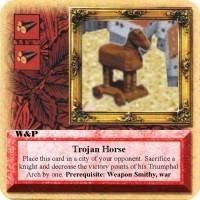 |
Trojan Horse (1x)
Place this card on a free building spot in a city or on one of the four Unit building spots in a Metropolis of your opponent. It blockades that building spot. When you sacrifice any Knight of your choice you may remove a Victory Point from an opponent's Triumphal Arch (rotate it backwards by 90 degrees) resp. destroy the Triumphal Arch (place it face-up next to the Development Stacks again) if it only shows 1 Victory Point. Afterwards the Trojan Horse is removed to the Discard Pile. The Trojan horse does not count as a building, i.e. it can be stolen by a Spy, but it can be destroyed by an Arsonist. The Trojan Horse can only be built during war (for 2 Timber) and has the Weapon Smithy as a prerequisite. |
|||
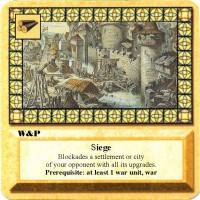 |
Siege (2x)
Playing this Action Card costs you 1 Timber. Place this card on any Settlement or City (not a Metropolis) of your opponent, which is then blocked together with its Upgrades until it is peace again, until your opponent wins a Battle or until Armistice is rolled. Any function of any Upgrade in the City / Settlement cannot be used, Knights and Fleets cannot be moved away, and the Victory Points do not count. This card may only be played during war. Furthermore you have to own at least one War Unit in your Principality. |
|||
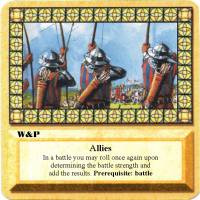 |
Allies (2x)
During a Battle (of any type) you may roll the Production Die once again upon determining the Battle Strength, even if your opponent has already rolled the Die. The rolled number is added to your Battle Strength. This card may only be played during a Battle. |
|||
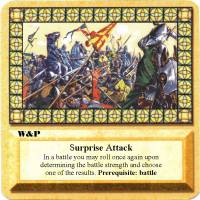 |
Surprise Attack (2x)
During a Battle (of any type) you may roll the Production Die once again upon determining the Battle Strength and then choose one of the results. |
|||
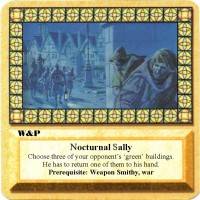 |
Nocturnal Sally (2x)
Choose 3 of your opponent's 'green' Buildings. He has to return one of them to his hand. Prerequisite: Weapon Smithy, War |
|||
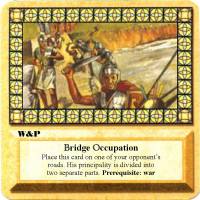 |
Bridge Occupation (2x)
Place this card on one of your opponent's roads. It divides his Principality into two parts, i.e. he now has two different Principalities with individual capabilities. For instance, Waterworks only counts for the part it is built in, Resources may not cross the border between the Principalities etc. If, for example, your opponent wants to build a road, he has to pay the building cost with resources of the respective part. Upon playing the Bridge Occupation you have to determine to which of the Principalities the two adjacent Region Cards belong. Regarding Action and Event Cards your opponent has to choose, to which of his Principalities the cards apply (e.g. Productive Year, Crop Rotation). During Battles he may only use Knights, Fleets and War Units of one part, but of course only those can be lost upon a defeat. The Bridge Occupation remains effective until either the war ends or your opponent wins a Battle. Prerequisite: War |
|||
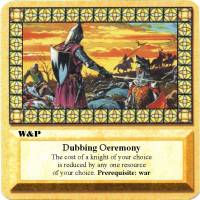 |
Dubbing Ceremony (2x)
Since you want to dub a squire because of his deed on the battle field you don't have to pay the full price. The cost of a Knight of your choice is reduced by any one resource of your choice. This card may only be played during war, but not necessarily during a Battle. |
|||
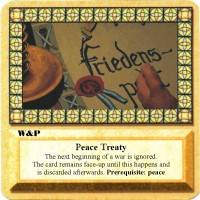 |
Peace Treaty (1x)
The next beginning of a war (the black question mark) is ignored. This card may only be played during peace. The card is placed next to the Event Card Stack, where it remains until the next black question mark is rolled. |
|||
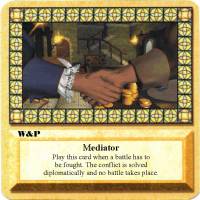 |
Mediator (1x)
Play this card when a Battle (of any type) has to be fought. The conflict is solved diplomatically, i.e. no Battle takes place. Of course there isn't a winner either. |
|||
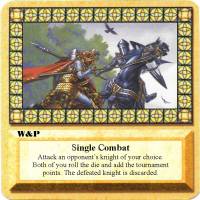 |
Single Combat (2x)
Choose one of your own and one of your opponent's Knights. Then both of you roll the Production Die and add the rolled numbers to the Tournament Points of the respective Knights. The one of you who has more points wins the Single Combat, the other one has to put his Knight under a development pile. In case of a tie the defender wins! |
|||

|
DOWNLOADS
For the downloads we provide several pages. |
|||